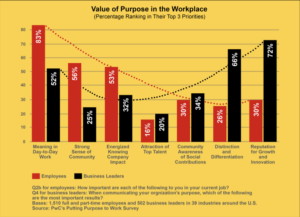Red e App recently published a whitepaper entitled “Strange Bedfellows: The Convergence of Innovation and Compliance in Long Term Care” – focused on the future of the long-term healthcare workforce, the role technology will play, and why compliance and innovation must coexist. This post is an excerpt from the full document, focusing on Work Trust, and is part of a series of blogs that will be released discussing various topics from the whitepaper.
In our previous post, we covered Work Trust and how it is vital to the success of any company that has a deskless workforce. This post continues the topic of Work Trust by looking at significant changes in how employees view their companies. Spoiler alert: the stakes are high, and the bar has been raised.
Investment in Work Trust needs to be intentional and informed by a clearly defined problem, e.g. ‘I need to create a culture of work trust through greater inclusion of my non-desk workers’. This is in contrast to an approach whereby one jumps into generic solution mode, e.g. ‘I need to send out a weekly newsletter’. The latter does not address the core need, nor does it allow for measurement of success or failure based on a common understanding of a baseline position.
The former provides the opportunity to baseline the current situation, map out the desired outcome, analyze the gaps between the two positions, and come up with specific actions to address those gaps. The impact of this approach will most certainly be greater and have more lasting effects.
Progressive organizations are constantly reading the tea leaves and looking to stay ahead of industry workforce trends. They also recognize that you must invest in operational infrastructure that is specifically architected for connecting with the workforce, just as they would invest in products or services. Operational infrastructure is a key component in the empowerment of leaders, who, without a highway that connects them to their peers and direct reports, would underperform on the aforementioned measures of success. This is particularly felt when the beneficiaries of communication are non-desk workers, who typically operate without email and other platforms that information workers enjoy, and as such are disconnected by default.
Given the current and foreseeable issues surrounding talent acquisition and retention, companies who do not make necessary adjustments in their view of the stakeholder landscape will find that their human capital management challenges only increase. In the past, the power dynamic between various stakeholders would have very much sat with shareholders, and/or the corporate entity who was spoilt for choice in terms of staffing. Over time this stakeholder group has grown to increasingly include the needs and expectations of customers (or residents and their families in the case of long-term care), the community at large, special interest groups, and current and prospective employees, to name a few.
What has been driving this expansion?
The power dynamic shift is mostly down to simple changes in supply and demand. As competition for the best employees increases, companies need to increasingly focus on the needs of those employees to attract and retain the best talent. Those needs might be monetary, and they could equally be non-monetary. Broadly speaking, there has been a slow-developing shift from a purely monetary-driven economy to a purpose-driven economy. This has impacted all industries and is a reflection of the attitudes and priorities held by new generations of workers and consumers alike, in part informed by corporate excesses of the past that have put the interests of executives and shareholders above all else.
To see this shift, all one needs to do is to look at how the retention data has changed. In a recent study by PwC, millennials were 5.3 times more likely to stay at a company when they had a strong connection to their employer’s purpose. In contrast, non-millennials were only 2.3 times more likely to stay given a strong connection to the employer’s purpose. Furthermore, when studying the differing perceptions of what adds value within an organization, one can quickly see a gap between employees and business leaders.
This gap is significant not only for the reason that leadership and the workforce are often misaligned but also because this misalignment can lead to disillusionment. According to Gallup, a sense of engagement is directly correlated to an employee’s ability to find meaning in their daily work, access to developmental opportunities, and clarity about their role. It follows that if there is a misalignment between what leadership deems to be core to its purpose versus that of employees, then communications, support, initiatives and the like will miss the mark with the workforce.
Up to this point in our series, we have learned what work trust is and why it’s worth the investment. Are you now wondering how exactly to execute and start to build work trust? Your starting point should be building excellent communication with the deskless worker. In our next post in the series, we will take a look at the two primary considerations when it comes to maximizing the impact of communications.
In the meantime, read the entirety of “Strange Bedfellows: The Convergence of Innovation and Compliance in Long Term Care“, and visit us at workrede.com to learn more about connecting with your deskless workforce.
Feature Image Credit: Magda Ehlers from Pexels

